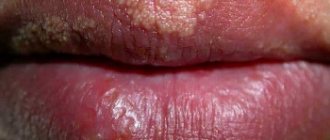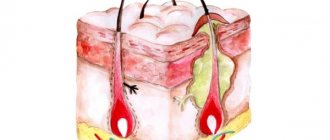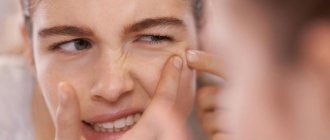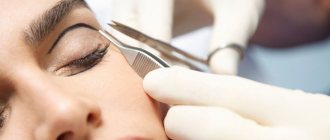by Doctor
Categories:
- Allergy treatment
Currently, peeling is a popular method of skin rejuvenation used in cosmetology. As the number of people using this service increases, the number of side effects of this procedure also increases.
Why can peeling be dangerous?
Skin peeling carried out using chemicals has a number of side effects, such as complications. The most dangerous to health is an allergy to peeling in response to the substances used in this procedure. This is a rather rare complication that, however, requires attention from a cosmetologist-dermatologist and immediate treatment.
Causes of allergies
The active peeling chemical may be:
- pyruvate, lactate, gluconate;
- carboxylic acids (eg trichloroacetic acid);
- retinol (a preparation based on plant extract);
- phenol (used for deep peeling);
- salicylic acid, etc.
It is important to understand that depending on the physiological and genetic characteristics of each person, an allergic reaction can develop in response to any agent used. Also, it should be noted that allergies to chemical peeling occur much more often than to mechanical peeling, and the deeper the penetration of the active substance, the greater the risk of complications.
An allergy to retinol peeling develops due to the presence of sensitization (hypersensitivity) to the peeling components and consists of an inadequate reaction of the body to the penetration of these components into the skin. There is an active release of a large amount of histamine from the cells, which leads to the expansion of capillaries and the occurrence of tissue edema.
In addition to a direct reaction to the active substance, skin hypersensitivity may be associated with a general increase in the sensitivity of the affected areas of the skin to mechanical, temperature and other types of influences.
Symptoms of allergy to peeling
Typically, an allergy to peeling is manifested by local symptoms, the boundaries of which, however, are not limited to the peeling area and may extend beyond it. As a rule, allergic reactions occur immediately after the procedure.
Signs of an onset allergy are:
- Rapid onset of skin swelling (within the next few hours after the procedure);
- Redness of the skin;
- Painful sensations may occur;
- Severe itching and burning sensation.
What to do if you are allergic to peeling?
It is advisable, instead of treating allergic complications, to prevent them. As a rule, in order to avoid the development of allergies, before the procedure it is possible to do a test for individual sensitivity and tolerance to the chemical substance used in peeling. This will reduce the risk of this complication and will also help avoid exposure to allergens (individual for each person) during recovery after the procedure.
Treatment of allergic manifestations after peeling
If signs of an allergy appear, you should immediately consult a doctor for medical help, as this condition can pose a threat to the health of the entire body. Severe cases may even require treatment in a hospital setting.
Popular allergy medications
- As a rule, the doctor prescribes antihistamines (H1 histamine receptor blockers), for example cetirizine, diphenhydramine, suprastin, loratadine and others. They can be prescribed either orally (orally) in the form of tablets, or intramuscularly or intravenously (parenterally). It is also possible to use them locally in the form of ointments or creams applied to the affected skin.
- In cases of ineffectiveness of antihistamines, the use of glucocorticosteroids (cortisone, hydrocortisone), both locally and systemically (in cases of severe and rapidly progressing allergies) is indicated.
With timely treatment, allergy symptoms usually subside quickly.
How to treat allergies after peeling with folk remedies?
An ointment made from the following components is considered a good remedy:
- Twist 2 leaves of fleshy aloe in a meat grinder, add 1 egg white. Stir the resulting mixture thoroughly. Apply to affected areas of skin. The ointment should be stored in a cool place for no more than 3 days.
Rate this article
If you find an error in the text, be sure to let us know about it. To do this, simply highlight the text with the error and press Shift + Enter or simply click here . Thank you very much!
Thank you for notifying us about the error. We will fix everything soon and the site will become even better!
Peeling (or as it is also called exfoliation) is a cosmetic procedure that removes dead cells from the upper layer of the epithelium. Nowadays, this process has become very popular among women, since it is thanks to it that you can very easily and quickly rejuvenate your skin.
What are the dangers of peeling?
It is also important to understand that an allergy to this session is a non-standard and even sometimes aggressive response of any living organism to certain substances of artificial origin. Irritants enter you through the top layer of the epidermis or through the mucous membranes.
Depending on the mechanism and substances used in such a session, they are divided into:
- chemical;
- enzymatic;
- mechanical;
- laser;
- radio wave cleaning.
Depending on the depth of the impact of such a process, it is divided into superficial, middle and deep types. Unfortunately, in our time, allergies to peeling are quite common; this occurs through a negative reaction of our body to the means used to perform such a session.
“How easy it is to get rid of allergies. A proven method is to write down the recipe. » >>
Exposure to chemicals on skin
Chemical cleansing of the top layer of skin has a whole bunch of side complications. Dangerous effects can occur when certain substances are used in such sessions. Any complications during such a session require immediate treatment.
WHY ARE CONTRAINDICATIONS TO PEELING NEEDED?
Restrictions on exfoliation techniques (whether mechanical, acid, laser or any other) are designed to minimize possible complications after the session. These include, for example, prolonged redness of the facial skin or the formation of scar tissue.
Most often, Internet users are interested in contraindications for chemical peeling of the face, since chemical methods are the most accessible for home use, including financially. However, in most cases, medical prescriptions are the same: no matter what type of peeling we are talking about.
10 relative contraindications
Relative prohibitions include those that are temporary. Such temporary contraindications still need to be taken into account, even before superficial peeling (for example, a scrub).
If at least one of these risk factors is detected in a patient, the procedure should be postponed for the period of treatment or simply until “better times” arrive. These contraindications include:
- Pregnancy and breastfeeding;
- The first days of menstruation;
- Pimples with a purulent core;
- Wounds, scratches at the treatment site;
- Fresh (up to 14 days) tan;
- Recent (up to 14 days) beauty injections;
- Colds;
- Feverish conditions;
- Taking retinoids;
- Demodicosis (subcutaneous mite).
10 absolute contraindications
There is practically no opportunity to exfoliate the face with peeling for such categories of people who need treatment for too long. It is better for them to choose an individual course of cosmetic procedures: it is so unnecessary in such cases to provoke complications.
We recommend: ABR PEELING: triple beauty power in one bottle
The list of absolute contraindications includes:
- Oncological diseases;
- Cardiovascular abnormalities;
- Herpetic infection;
- Diabetes;
- Very dark skin;
- Kidney failure;
- Mental disorders;
- Tendency to form keloid scars;
- Neoplasms (papillomas, moles) in the area of intended treatment;
- Individual intolerance.
Causes of allergies
The chemical process uses the following substances that may cause intolerance:
- Pyruvate.
- Lactate.
- Calcium gluconate.
- Carboxylic acids.
- Retinol (medicine created using plant extract);
- Phenol (used for strong cleaning);
- Salicylic acid.
It should be noted that these drugs are quite toxic and can cause severe complications.
It is also very important to understand that the response to such a process can be very different for everyone, since our bodies react individually to all stimuli. Also, you need to understand that intolerance to dry cleaning is much more common than to mechanical or other types. Depending on how deep this procedure is done, symptoms of complications will appear.
An allergy to retinol peeling will make itself felt with increased sensitivity (in medicine called sensitization) to some components of this procedure and causes intolerance to it when it comes into contact with the upper layer of the epidermis. When this happens, an active release of histamine begins in your body, which causes tissue swelling and dilation of capillaries in the blood.
But in addition to this reaction of the body to this substance, intolerance can occur through a general hypersensitivity of some areas of the epidermis to chemical or mechanical actions on their surface.
Causes of complications after peeling
Complications after chemical peeling are divided into:
- predictable;
- unpredictable.
Predicted complications are expected complications that are inevitable during invasive manipulations. They arise as a result of the body’s normal reaction to skin trauma (chemical, mechanical or other action).
Erythema, which is persistent severe redness of the treated area. The severity and duration of its persistence depend on the aggressiveness of the technique. This complication often occurs in people with enlarged vascular networks on the face after deep peeling.
Unpredictable complications are unforeseen complications that, in principle, should not exist, but, unfortunately, they do happen. Often the cause of such complications is the doctor’s unprofessionalism, violation of the rules of asepsis and antisepsis by both him and the patient, violation of peeling techniques, and the cosmetologist’s erroneous determination of the initial condition of the skin: its thickness, phototype and sensitivity.
A series of complications is associated with the one-sided approach of the cosmetologist to the selection of patients for one or another peeling method, as well as to the one-sided management of pre- and post-peel measures.
Very often complications arise due to the fault of the patients themselves. Violation of the schedule of post-peeling activities will negate the effect of the procedure. The most common violations by patients include failure to comply with the cosmetologist’s prescriptions: exposure to the sun and ultraviolet irradiation, forcible removal of scabs, and giving up bad habits. The patient’s serious and responsible attitude towards post-peeling measures contributes to the rapid completion of the rehabilitation period.
The patient's health status at the time of peeling and the combination of different therapy methods can cause complications after exfoliation. For example, the patient does not inform the doctor about the presence of a concomitant disease or about the therapeutic treatment carried out during this period. In this case, any invasive intervention in the body can give an unexpected result.
For example, the use of hormonal drugs during the procedure may increase the risk of excessive hyperpigmentation. Pathological processes of the genitourinary system also contribute to the persistent development of hyperpigmentation, and peeling will not help here, but will only aggravate the problem. Performing deep peels and using the retinoid isotretinoin (a drug that contains vitamin A) can affect the healing process of scars.
Complications. occurring after laser exposure: 1. Erythema and swelling of facial tissues on the 6th day after laser dermabrasion 2. Point hemorrhages from damaged small vessels with the formation of small hematomas after the Fraxel laser.
Unpredictable complications include individual characteristics of the body. In this case, it is very difficult to predict possible side effects and complications. Since everything directly depends on the genetic characteristics of the skin, the body’s metabolism and the patient’s lifestyle.
Bad habits affect the progress and complications of the peeling procedure. For example, the presence of such a bad habit in a patient as smoking contributes to pathological scarring of tissue, and recovery after any cosmetic procedures is much more difficult for them.
Exfoliation is carried out using various chemical agents, as well as their combinations. For this reason, each exfoliation method has its own mechanism of action, as well as possible complications and side effects. For example, the use of phenol as a chemical agent can provoke poisoning, so you need to correctly take into account its concentration, remembering its high toxicity.
To summarize, let’s say that there are a number of objective reasons due to which one cannot be completely insured against complications. This depends on the effect of chemical agents on the skin, that is, the more aggressive the technique is chosen, the more serious the complications after peeling can be.
Let's once again name the reasons that cause side effects and complications after exfoliation:
- violation of the integrity of the skin;
- individual characteristics of the skin and body;
- features of the methodology;
- lack of professionalism of the doctor and irresponsibility of the patient;
- general health of the patient.
Symptomatic manifestations
Allergy symptoms after peeling are expressed almost instantly after this procedure. As a rule, manifestations can be not only in those areas where the session was performed, but also extend beyond the areas where the epidermis was cleaned.
It is worth noting what are the main symptoms of intolerance to this process:
- Within an hour, swelling occurs in the areas of the skin where the cleansing was carried out.
- The areas where the procedure was performed may become red and painful.
- A feeling of discomfort, a painful sensation throughout the body.
- Severe itching begins in the areas where the epidermis is cleaned.
- There is a feeling of burning skin.
Redness and burning of the face
Remember that with serous exacerbations, you can damage the layers of the epithelium so much that you will need to undergo surgery or plastic surgery.
Treatment of symptoms
If you identify signs of intolerance, you should immediately consult a dermatologist so that you can receive first aid, since your body may be in serious danger. In case of severe and painful reactions, treatment may be carried out in a hospital setting. First of all, your doctor will prescribe you H1 histamine receptor blockers (antihistamines and allergy shots):
There are many good medications available today that will help you with your symptoms. These medications do not cause drowsiness and are completely safe for your body. These drugs can be used either orally, using tablets, or intramuscularly or even intravenously using droppers and injections. They can also be used in the form of ointments or creams, which should be applied to the affected area of the epidermis.
Allergies after peeling can also be treated with folk remedies. You can make a good ointment yourself. Recipes are easy to find on the Internet. But remember the most important thing: if you take care of your health, then the manifestations of such an unpleasant reaction may stop bothering you. And do not forget to consult your doctor; traditional medicine will not harm your body.
Peeling is one of the most popular procedures for improving the condition and appearance of the skin. Despite the differences both in depth (superficial, medium, deep) and in the mechanism of action (laser, chemical, mechanical, etc.), all types of peelings have one goal - to remove the surface layer of cells. Accordingly, possible complications and side effects after peelings are also similar.
They may vary in severity and frequency of occurrence (for example, with chemical peeling, complications occur much more often than with mechanical peeling), but none of the procedure methods can fully protect against them.
Expected complications after peeling
This group includes problems that manifest themselves to one degree or another in most patients. As a rule, they occur in the first days (up to two weeks) after peeling, and pass quickly enough and without any consequences - in fact, these are not “side effects” or complications, but a completely predictable reaction of the skin to external irritants, which needs to be addressed be ready.
This is redness of the treated area, and the degree of its severity and duration of existence directly depend on the “aggressiveness” of the procedure. For example, if there has been exposure to alpha hydroxy acids, the redness will persist for up to 3 hours, but after treatment with Jessner's solution, the erythema will last up to two days. An acid concentration of about 30% with medium TCA peels will cause bright red erythema for up to 5 days, and with deep peels, laser resurfacing or dermabrasion, redness can persist for up to 2 months.
Also quite common. It passes quickly (1-3 days) and is practically unnoticeable after fruit peeling, but resorcinol and trichloroacetic acid can cause large scaly peeling of the skin for a whole week. During this period, it is important to resist the temptation to “help” your skin exfoliate, leave the scales alone and let the process take place naturally (if you still really want to participate in some way, it is better to take care of actively moisturizing the skin)
This is a kind of local inflammatory reaction of the skin to external influences. Since capillary permeability increases after peeling, fluid leaves them and accumulates in the tissues, causing swelling. This problem is especially relevant for areas with thin skin - around the eyes, on the neck. Fruit acids will not have such a side effect, but retinoids and TCA, the concentration of which does not exceed 15%, may well do so. As a rule, swelling occurs 1-3 days after the procedure and persists for several days. Minimizing their manifestation is the task, first of all, of a cosmetologist who must select the right combination of acids for the patient’s skin type.
One of the “complications” most disliked by patients is the pronounced dark coloration of the treated skin. However, there is no reason to worry here; this trouble goes away after the skin completely peels off - on average, after 1-2 weeks.
Treated skin areas react more sharply to any external irritants (sunlight, mechanical and temperature influences, etc.). As a rule, this condition goes away within 1-2 weeks, but it can also develop into an independent complication - in this case, hypersensitivity persists for up to 12 months.
Unexpected complications and side effects of peeling
These problems can appear either immediately or quite a long time after the procedure. They are not among the natural reactions of the skin to peeling, have an extremely negative impact on its aesthetic result, and in most cases pose a health threat and require one or another treatment.
This complication is typically associated with medium to deep chemical peels. laser resurfacing and dermabrasion. The risk group primarily includes patients with recurrent herpes, but clinical practice also knows many cases of primary infection associated with decreased immunity - an inevitable consequence of serious peelings. As a preventative measure, antiherpetic drugs (for example, acyclovir) are usually prescribed, and if the moment is missed, a full course of treatment will be required.
In this case, the trigger will be a violation of hygiene standards by doctors during the procedure, or by the patient himself during the rehabilitation period. The main manifestation is streptostaphyloderma, which is treated by taking appropriate antibiotics in ointments or tablets (depending on the severity of the process).
According to statistics, a complication in the form of an allergy to the acids used during peeling is rare (mainly a reaction to ascorbic and kojic acids). But the reaction to other external stimuli may turn out to be unexpectedly strong - i.e. something that normally causes at most a slight itching, immediately after peeling can provoke, for example, bright hives and severe swelling.
To avoid such troubles, before the procedure it is necessary to undergo a sensitivity test to peeling preparations, and also to exclude the influence of other allergens during the recovery period (everything here is strictly individual, since everyone has their own). Such complications are treated with antihistamines and steroids (tavegil, dexamethasone)
This complication is a consequence of the death of a large number of melanocytes, which is possible with rough grinding or too deep chemical exposure. People with dark skin often experience this effect especially often. The most unpleasant thing is that the situation is almost impossible to correct, but with the help of additional superficial peels you can try to slightly even out the tone.
A common problem for patients with dilated superficial skin vessels (telangiectasias) who decide to undergo deep peeling. Such an adverse skin reaction can last up to 12 months, but in the end, as a rule, goes away on its own without outside intervention. To speed up this period, it is important to avoid sun exposure, saunas, excessive physical activity, and avoid the consumption of alcohol, hot and spicy foods.
This complication is most often observed after laser and TCA peeling and is a direct consequence of poor pre-procedural diagnosis. The cause of hyperpigmentation is the incorrect functioning of inflamed skin cells, which begin to actively produce melanin, which leads to the formation of dark areas.
A thorough medical examination can protect you from this problem (it is necessary to find out whether there is a predisposition to hyperpigmentation and to cure all existing inflammatory processes). If there is an existing problem, additional retinoic or phenol peels will help (exfoliate pigment cells), as well as mesotherapy based on 10-20% ascorbic acid (breaks down melanin).
- Exacerbation of acne (acne) and seborrhea
The provoking factor for this complication is an inflammatory reaction that encourages the cells “responsible” for the formation of sebum (sebocytes) to work actively. Patients with oily skin, chronic seborrhea and acne after laser resurfacing are at risk. deep or medium peeling.
The main preventive measure is to take the Aevit multivitamin complex, and if inflammation cannot be avoided (usually it appears 2-4 weeks after the procedure), antibiotic therapy is carried out.
This term refers to a clearly defined line between the treated and untouched areas of the skin. This situation is not uncommon among patients with porous skin and dark skin who have undergone laser, deep or medium-deep peeling. This “border” can be smoothed out using additional Jesner peeling.
This is the most unpleasant complication that occurs due to skin damage after deep chemical peels (50% TCA, 88% phenol), or due to a violation of the procedure technique itself with 30% TCA peeling.
Peeling (or as it is also called exfoliation) is a cosmetic procedure that removes dead cells from the upper layer of the epithelium. Nowadays, this process has become very popular among women, since it is thanks to it that you can very easily and quickly rejuvenate your skin.
Acceptable consequences of peeling
After deep cleansing with laser, dermabrasion and chemical peeling, the following consequences are expected:
- Erythema or severe facial redness in the treatment area. The more aggressive the impact, the stronger the redness will be. If post-peeling care is not disturbed, the side effect goes away on its own. If the patient does not follow the care specialist’s instructions, visits baths, or drinks alcohol, then the erythema may intensify and last for a long time.
- Pronounced peeling. Thus, the skin rejects damaged fibers and is renewed. It is impossible to tear off or rip off loose films - this is dangerous due to scars and the appearance of wounds. In some cases, cosmetologists recommend that large sagging areas be carefully trimmed without touching the skin. To speed up renewal and the passage of peeling, cosmetologists insist on using wound-healing ointments.
- Mild swelling in sensitive areas (near the eyes, mouth). Increased permeability of small vessels in these areas provokes fluid accumulation. Swelling persists for up to 3 days and goes away on its own.
- Tightness of the integument. The characteristic discomfort can be reduced by regular application of moisturizing cosmetics and tonics. Cosmetics must be non-allergenic and approved by a cosmetologist.
- Darkening of the skin (even). Goes away on its own in 7–10 days.
- Increased susceptibility (sensitivity) of the integument. This deficiency can last from 1 week to 1 year. It is expressed in a sensitive, sometimes painful reaction to sunlight, temperature changes, touch and mechanical stress.
The predicted effects of peeling are temporary and do not require additional therapy, only observation and skin care prescribed by the cleansing technique.
And a little about secrets...
The story of one of our readers, Irina Volodina:
I was especially distressed by my eyes, which were surrounded by large wrinkles, plus dark circles and puffiness. How to completely remove wrinkles and bags under the eyes? How to deal with swelling and redness? But nothing ages or rejuvenates a person more than his eyes.
But how to rejuvenate them? Plastic surgery? I found out - no less than 5 thousand dollars. Hardware procedures - photorejuvenation, gas-liquid peeling, radio lifting, laser facelift? A little more affordable - the course costs 1.5-2 thousand dollars. And when will you find time for all this? And it's still expensive. Especially now. Therefore, I chose a different method for myself...
>>
Content:
- Predictable complications after peeling
- Unpredictable side effects and complications of peeling
- Other infectious complications
Peeling is a fairly popular cosmetic procedure that can improve the appearance and condition of the skin. Peeling can have different depths of exposure and penetration of active substances; in addition, it can be mechanical, laser, or chemical. However, any peeling, carried out in a salon or at home, must fulfill its main goal of removing the surface layer of dead skin cells. This procedure is not recommended for every person, because it has a strong effect on the skin. It is worth understanding that peeling can cause some side effects and complications that are similar to each other.
Peeling may cause some side effects and complications
Such manifestations may differ in frequency of occurrence and severity, and they also occur differently for each type of peeling. For example, after a chemical peel there are many more complications than after a mechanical type of procedure. However, none of the varieties of this procedure provides a guarantee that a person will definitely not experience any complications or problems after it is performed.
After a chemical peel, a much greater number of complications occur than after a mechanical type of procedure.
Predictable complications after peeling
This includes complications after the procedure, which in one way or another manifest themselves in most people who have undergone a salon peeling session. Such complications should be expected within the first two weeks after the procedure, and they resolve on their own and in a short time. For this reason, they should not be classified as complications or side effects; they are just a skin reaction to this cosmetic procedure.
Erythema
Erythema is the redness of the skin area treated with peeling, and the duration and severity of the manifestation depends on how “aggressive” the peeling was chosen for use in each individual case. For example, if the procedure was performed on the basis of alpha hydroxy acids, then redness can last about three hours. After a Jessner peel, erythema may persist slightly longer - about a couple of days. If a medium acid-based TCA peel was used, the erythema can last up to five days, and after deep peels, dermabrasion and laser resurfacing, the erythema lasts about 60 days.
Erythema
Peeling skin
Many people are familiar with this manifestation in everyday life, and peeling usually occurs due to excessive dryness of the skin. However, the peeling of the skin that occurs after peeling goes away within a few days. When using soft peelings, peeling is almost unnoticeable, but if strong chemical solutions were used, then within a week the skin will peel off on its own with large flakes of dead and treated cells. At this time, you cannot promote this process, otherwise you can seriously damage the skin. The process should proceed naturally and complete on its own, especially if you promptly moisturize and nourish your skin.
Swelling
Edema is a local inflammatory skin reaction to external influences. After a peeling session, capillary permeability increases, so liquid comes out of them, which then accumulates in the tissues, thereby causing swelling. This problem is especially expected for the skin in the neck and around the eyes, because there it is most delicate, thin and vulnerable. Peeling based on fruit acids is practically incapable of causing this skin reaction, but any stronger peeling can lead to swelling. They appear in a few days or less, while remaining on the skin for some time. Your specialist can minimize the skin's reaction to peeling if he can choose the right composition for your specific skin type.
Skin darkening
This manifestation can occur on the skin, but there is no need to worry about it. The darkening goes away on its own after skin exfoliation.
Skin darkening
Increased skin sensitivity
After peeling, the skin exposed to the peeling may react more strongly than usual to any external irritants. The problem goes away on its own after a couple of weeks, but it can become a complication, and then the increased sensitivity can last a year.
Unpredictable side effects and complications of peeling
These problems can appear either a few hours or a long time after peeling. They should not be classified as expected complications and skin reactions to the procedure. It is such manifestations that can not only spoil the entire aesthetic effect created by peeling, but in many cases threaten human health and require treatment.
Herpes virus infection
This complication in most cases is caused by deep and medium chemical peels, as well as dermabrasion and laser resurfacing. Patients with recurrent herpes are especially at risk in this case, but it also happens that strong peelings cause primary infection due to a decrease in immunity caused by the procedure. Your doctor may prescribe medications to eliminate the herpes virus, but sometimes more complex treatment may be required.
Herpes
Other infectious complications
In this situation, the activation of the problem may be associated with a violation of hygiene standards by medical personnel during the procedure, or by the patient during the recovery process after peeling. The main manifestation is streptostaphyloderma, which can be cured by taking appropriate antibiotics appropriate to the severity of the process.
Allergic reactions
The skin after a peel remains unprotected for some time, so something that has not caused an allergy in the past or caused mild itching can cause significant swelling and hives in the skin damaged by the peel. To prevent this from happening, take a sensitivity test to the peeling components and eliminate the influence of allergens during the rehabilitation period. This complication can be eliminated with steroids and antihistamines.
Skin marbling
This problem is a consequence of the death of a huge number of melanocytes caused by deep chemical peeling or aggressive skin resurfacing. Patients with dark skin are especially at risk. This situation is considered almost irreparable, but with the help of secondary sessions of superficial peeling, you can slightly even out the tone of damaged skin.
Persistent erythema
This complication often occurs in patients who have dilated superficial skin vessels and decide to undergo deep peeling. This skin reaction can last up to a year, but after that it often goes away on its own. To speed up rehabilitation, avoid alcoholic beverages, spicy foods, saunas, baths, beaches and gyms.
Skin hyperpigmentation
This complication often occurs after TCA peeling or after this procedure performed with a laser. Hyperpigmentation occurs due to poor diagnostics before the procedure. The work of improperly processed skin cells that actively produce melanin leads to the formation of dark skin areas.
If you want to avoid this problem, it is recommended to undergo a full medical examination. If the problem already exists, then mesotherapy based on ascorbic acid or phenol and retinoic peels can help.
Exacerbation of seborrhea and acne
This complication is provoked by inflammation, which encourages the cells responsible for the formation of sebum to actively work. Patients with chronic seborrhea or oily skin are especially at risk after deep and medium peeling or laser resurfacing.
A preventative measure is to take a vitamin complex, and if inflammation has already occurred, then antibiotic therapy is carried out.
Seborrhea
Coarse scars can occur after deep chemical peels, or when the technique of TCA peeling is broken.
Appearance of the demarcation line
The demarcation line is a noticeable boundary between the untouched and peeled areas of the skin. This problem occurs in patients with porous or dark skin, especially after laser, deep or medium peeling. Smoothing of the boundaries of the demarcation line is carried out using Jessner peeling sessions.
Coarse scarring
Coarse scars can occur after deep chemical peels, or when the technique of TCA peeling is broken.
Facial peeling is one of the most common and effective procedures that does not cause significant damage to the skin. Of course, there are aggressive... >>
Useful article?
Save so you don't lose!
Doctor
How to avoid complications?
It is much easier to avoid post-peeling complications than to deal with them later. This is noted by both specialists and patients.
In order not to be upset by your reflection in the mirror, and also to enjoy a successfully completed peeling, cosmetologists strongly recommend paying attention to the following aspects of facial care before and after cleansing:
- If you are taking any medications, be sure to notify your cosmetologist. Many medications enhance the effect of acids and can be harmful during chemical peeling. This is especially true for retinoids and drugs in this group.
- Before and after deep cleansing, be sure to take antiviral medications. This will reduce the risk of exacerbation of herpes.
- After cleansing, it is important to use sunscreen cosmetics with the maximum degree of ultraviolet protection. This way, you will prevent skin hyperpigmentation.
- After peeling, you should not visit baths, swimming pools, solariums or play sports.
- Do not drink alcohol-containing drinks or spicy foods until the skin is completely restored.
- After cleansing, the skin’s immunity noticeably weakens; vitamin complexes, a variety of healthy foods, fresh fruits and vegetables will help partially support the body.
- During rehabilitation, put aside your usual cosmetics. Use only natural cosmetics recommended by specialists.
- Pay close attention to changes on your face. At the first suspicion of the development of complications, contact a cosmetologist. Timely prescribed therapy will help quickly eliminate possible troubles.
Peeling is stress and trauma for the skin, so it is very important to follow all the instructions of the cosmetologist and use high-quality cosmetics. Only proper care can guarantee high results and rapid restoration of the skin after peeling.
If you want to look beautiful, correct skin imperfections and avoid early aging, peeling is the surest way. Carefully study the technique of facial peeling and the consequences of the procedure, take a serious approach to choosing a clinic for it, and do not skimp on your health. The professionalism and experience of a cosmetologist is half the success, the other half depends on you and skin care after cleansing.











